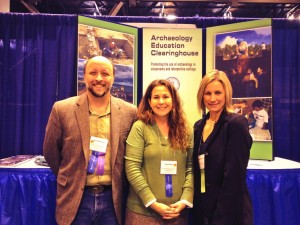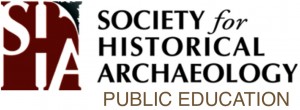This post began as a lesson in acronyms to explain SHA’s commitment and involvement with the AEC and NCSS. I’ll get to those in a minute, but the post has expanded due to recent events at the Society for American Archaeology (SAA) annual meeting to include discussion points on the future of public archaeology. We seem to be at an impasse for what we can achieve as separate societies and the need to work together or form another group was echoed in every public archaeology session I attended at SAA.
For me it comes down to the age old typology debate: are we lumpers, or are we splitters? The best answer: it depends. And it depends on the question you’re asking.
Is there enough public archaeology offered within existing professional organizations? The current model for public archaeology at SHA includes the active Public Education and Interpretation Committee (PEIC- of which I am chair), professional development workshops offered as the schedule will allow before the conference, organized panels and symposiums on the topic, a public day on the Saturday during the annual meeting, and general sessions where public archaeology papers are grouped together by the conference organizers. There’s also my favorite hybrid, integrated sessions where the lines between terrestrial, underwater, and public archaeology are blurred and tackle all subjects under a common theme. The SAA as well as other profesional societies including regional conferences have similar committees and offerings.
It seems like enough, yet the SAA electronic symposium “Getting Back to Saving the Past for the Future: Heritage Education at a Professional Crossroads” brought to light that compared to other professions, after 20 years archaeology hasn’t had nearly the impact or traction that other subjects are able to garner on a national level. Hence the crossroads.
The solution proposed at the close of the session by organizer Meg Heath was to form another organization. The Archaeology Institute of America (AIA) stepped up and offered a full day where archaeology educators could hold a conference during their annual meeting in New Orleans (January 2015). The idea came up naturally as their aia-outreach-and-education google group, which launched end of 2013, garnered hundreds of responses. Problematic for SHA members is that our conferences are scheduled nearly each and every year for the same dates in separate locations. Ben Thomas (AIA) suggested they host the southeast portion of the conference in New Orleans and SHA could concurrently host a northwest conference within our conference in Seattle. But not being in the same room, not having the same networking opportunities, and leaving it up to technology to bridge the gap between the two factions are serious obstacles to overcome. If I’ve learned one thing about conferences over the years: physical presence matters.
What are the other options? Here are four marinating in my mind.
Archaeology Education Clearinghouse (AEC)
SHA, SAA, and AIA already have a partnership in place, although its loosely defined and far too few people know it exists. The three organizations created the Archaeology Education Clearinghouse (AEC) as a convenience to sponsor a booth at the National Council of Social Studies (NCSS). NCSS is the penultimate meeting for social studies teachers, district level coordinators, administrators, and researchers in instruction and design. Over 25,000 teachers and administrators belong to NCSS and thousands attend approximately 400 sessions offered each year at their annual conference.

For the past seven years SHA has participated in the National Council of Social Studies (NCSS) annual conference through representation by the Archaeology Education Clearinghouse (AEC). We have the exhibitor booth and present a session on making the past come alive in classrooms using ready-made materials. This year the AEC expanded its traditional role and worked together over the year to develop handouts for educators specific to the grades and subjects they teach. While the main activity of our conference calls was organizing NCSS participation, we also discussed cross promotion of National Archaeology Day events and Boy Scout Jamboree.
The name Archaeology Education Clearinghouse is problematic. For one, most archaeologists are not aware the AEC exists. For two, the word clearinghouse implies we are a portal or an almanac for all archaeology education materials. But the name works for educators. They recognize what a clearinghouse is and it’s a very appropriate way to market to them at the conference—one stop shopping for them to gather resources and get to their next stop. For future joint public archaeology enterprises I hope the intent and framework of the AEC holds and increases in prominence. The three organizations should be working together to maximize efficiency for all of us doing this kind of work.
Project Archaeology
Another lumping option is to consider existing programs, such as Project Archaeology. This national program of the Bureau of Land Management (BLM) is housed at Montana State University and for 20 years they have researched, developed, and tested archaeology education materials for formal classroom settings that many of us have adapted for informal use. Their current flagship curriculum is Investigating Shelter, endorsed by the National Council of Social Studies. Project Archaeology is one of the only organizations with professional development opportunities for those interested in archaeology education. They have a national network of coordinators in place in 32 states. In addition to sessions on education trends and assessment, the bi-annual meeting always includes a reading circle on a current public archaeology work, and when possible the author(s) attend. Attendance is small but the framework and expertise is there.
Education Conferences
If we continue with lumping the societies together and we recognize that what we’re currently doing isn’t working, why not try a new model? What if those dedicated to archaeology education who generally meet before an archaeological conference met before an education conference: National Council of Social Studies (NCSS), National Science Teachers Association (NSTA), or North American Association for Environmental Educators (NAAEE)? Putting on a standalone conference is difficult work, but piggy backing on an existing one independent of when the big three meet seems a viable option. Rather than trying to bring educators to us, we go to them.
A New Society for Public Archaeology
This is the ultimate splitting option. We at SHA, more so than SAA or AIA, understand the reasons for needing to create a new society to further our own discipline. Coming up on the 50th anniversary of the founding of SHA, some of the very reasons for the formation of the society are being echoed within public archaeology circles. However, adding another meeting adds a financial constraint not many public archaeologists can manage. For myself, I rely on conferences to keep me current on archaeological issues and trends that is essential to my outreach work It would be difficult to have to pick one over another.
SHA: A Home for Public Archaeology
Whatever solutions are offered or new society put in place, I implore SHA members doing public archaeology to continue attending the annual meeting and keep infusing the creative work you are doing into the places provided by the society. Get involved with the PEIC, we are always open to new members and new ideas. Request professional development workshops you need to take your archaeology education programs to the next level. Share with colleagues successes and challenges, that’s the only way we’ll make progress on our long term goals. When you hit a an obstacle you can’t overcome yourself, organize a panel discussion to tackle the obstacle and foster growth within the society. Take advantage of the Public Day as an expo for the specialized work we do. And if you live near a host city for future NCSS (New Orleans 2015, Washington DC 2016, San Francisco 2017, Chicago 2018) come experience firsthand how important it is that we show up. It’s frightening- if it were not for us and our presence through the AEC, there would be no archaeology represented for our nation’s social studies educators.
So…are you a lumper or a splitter? Let us know what your thoughts are about the future of Public Archaeology in our discipline!


